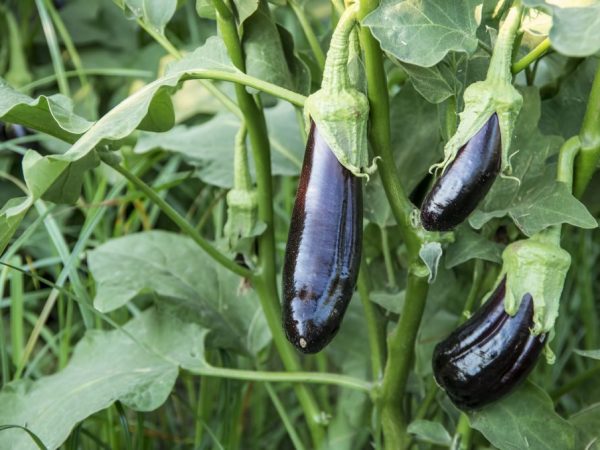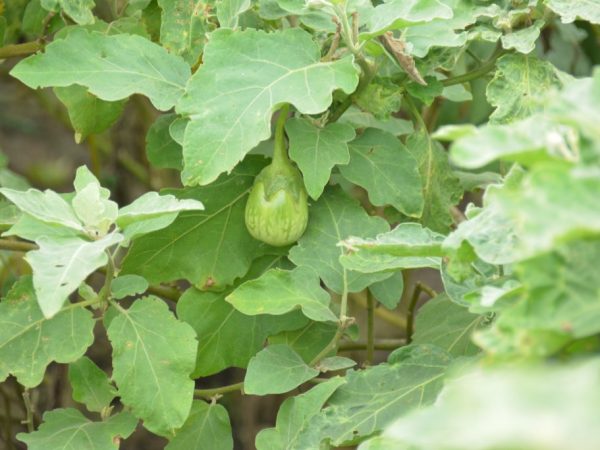Description of eggplant Galine
Galine eggplant of f1 category is characterized by high yield rates and attractive appearance. At the end of 2002, this variety was included in the State Register of the Russian Federation. Suitable for cultivation in the central and southern regions of the country.

Description of eggplant Galine
general information
Eggplant variety Galine, category f1, has an early ripening period - 110 days from the moment of seed germination.
The description indicates that the eggplant bushes are powerful, up to 60 cm in height. The crown is semi-spreading. The sheet plate is smooth, saturated green. The fruits are long, the weight of an individual fruit is 200-300 g. The color is dark purple. Productivity is high: up to 2.5 kg per bush.
Application
The description of the pulp indicates its creamy shade and high density. There is no bitterness in the taste, so the products are used for cooking without pre-soaking them in salt.
Galine fruits of f1 category are suitable for conservation. Thanks to their piquancy in taste, they make delicious salads and pickles.
The principle of correct cultivation
This culture is grown in the open field. To begin with, I plant the seeds in a container to get seedlings.
The seed planting process takes place in mid-March. To do this, the planting material must be treated with a manganese solution (5 g per 10 l of water), and infused in water for 20 minutes. After the empty seeds float up, they are not used for planting. The remaining suitable seeds are wrapped in a gauze cloth and placed in a freezer for 2-3 hours for hardening.
It is worth pouring 2/3 of the nutrient substrate into the planting container. Small holes are made in it, up to 1 cm deep. Seeds are planted inside and sprinkled with earth tightly. The container is placed in a warm room. During the day, the seeds are kept at a temperature of 24-27 ° C, and at night they are reduced to 17 ° C. Such a drop provides an acceleration of the sprouting process, and the seedlings will be more resistant to frost. After the first shoots, you should move the container to the windowsill. As soon as 2 pairs of leaves are formed on the seedlings, they begin the planting procedure in a permanent place.
The plots that you will be using for permanent growing should be fertile, protected from wind and drafts. We need low soil acidity (no more than 4%). Treat the land with a solution of lime (2 kg of the product per 1 m2). The culture is transplanted to a permanent place in late April or early May, when the soil warms up to a temperature of 10-13 ° C. When planting, they adhere to the 50x50 cm scheme.The planting depth should be 1-2 cm.
Care measures

Top dressing is carried out strictly at the root
It is worth watering the bushes of this variety as the soil dries out.
The optimal watering interval is 7-10 days, during which the soil is moistened to a depth of 10 cm. After watering, the soil is loosened and weeds are removed to reduce the risk of pests and diseases.
Top dressing is carried out as needed.If the flowering period is delayed, then it is worth feeding the bush with a solution of potassium nitrate (30 g per 10 liters of water). In case of poor fruiting, use a solution of superphosphate (50 g per 10 l of water) or ammonium nitrate (20 g per 10 l of water). Keep in mind that nutrient mixtures should not fall on the trunk or leaf plate of the bush.
Due to the high growth of the bush, the culture needs a garter. The formation of a plant consists in the removal of lateral and lower shoots.
Pest and disease control
- Root rot, late blight and moniliosis are often distinguished from diseases. An effective remedy against late blight will be a solution of colloidal salt (20 g per 10 l of water). To get rid of moniliosis will help the drug Zircon (30 g per 10 liters of water). With the help of these means, spraying is carried out at intervals of 10 days. It is impossible to cure a culture from root rot. You will have to completely remove the bush. As a preventive measure, the process of watering and loosening the soil is normalized.
- Aphids and midges are the main pests of the plant. In the fight against aphids, a solution of a copper-containing drug Oxyhom (40 g per 10 liters of water) will help. Treatment against midges consists in spraying with a solution of Bordeaux liquid (8 g per 10 liters of water).
Conclusion
It is not difficult to grow Galine eggplants if you follow the above recommendations. The main requirement for the gardener is that he must pay attention to all changes in the appearance of the bush and, at the slightest danger of a disease or pest, immediately fight them.

